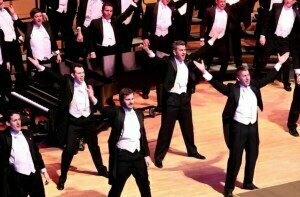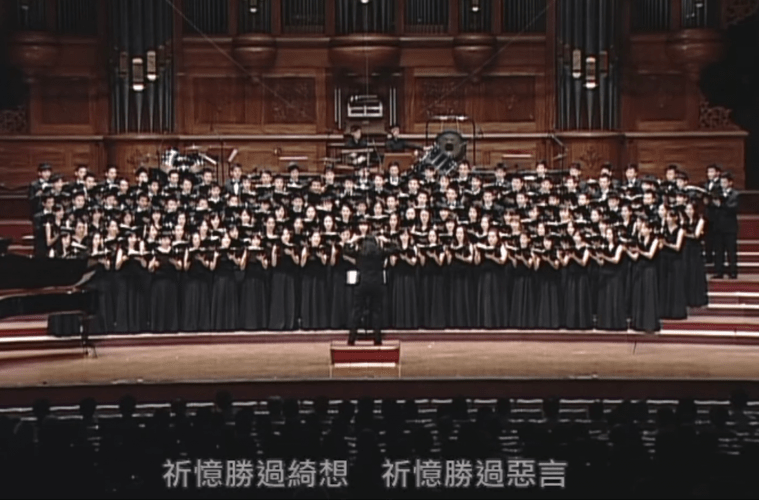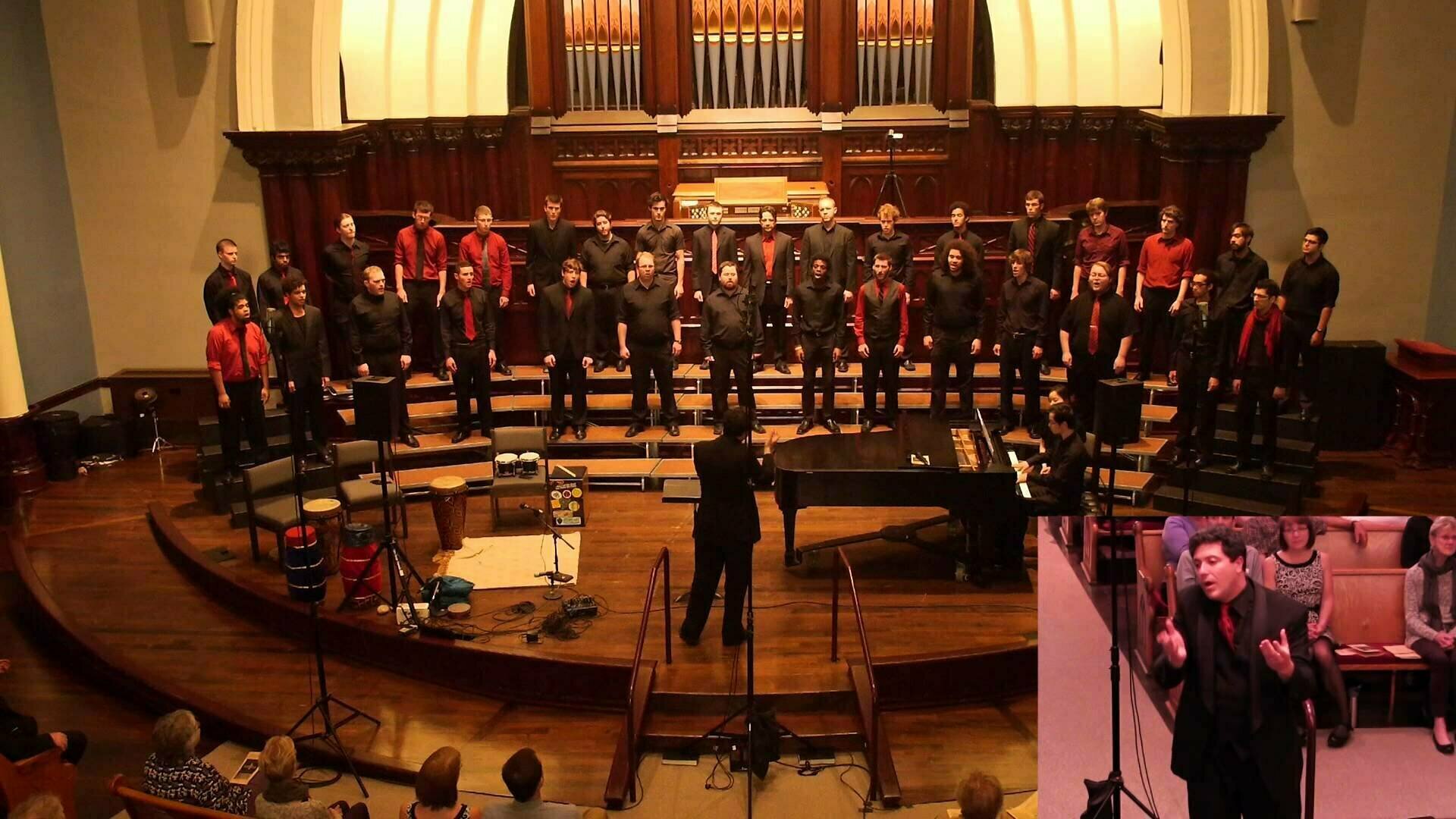 The most common form of popular music in India is film music – songs from the movies, and Sperry has not shied away from adapting this form for choirs.
The most common form of popular music in India is film music – songs from the movies, and Sperry has not shied away from adapting this form for choirs.
Popular Music in Choral Format
As mentioned in Part I of this series, the Natya Shastra intertwines drama, music and dance. Contemporary Indian movies, though poles apart from the ancient Sanskrit treatise, do the same. Most Indian movies are musicals with a dance number or two tossed in amid high drama, very often melodrama.
The Indian diaspora and Indophiles around the world who follow Indian film music know A. R. Rahman well but most Americans discovered him after he won two Academy Awards (Best Score, Best Song) for “Slumdog Millionaire.” Sperry is a frequent collaborator with Rahman, and is a consultant for Rahman’s music college in Chennai, the KM College of Music and Technology.
Sperry has arranged some popular Rahman songs for choirs. Of these, the favourite (Google and YouTube indicate that choirs all over America go for it) is “Balleilakka” from the 2007 Tamil movie “Sivaji: The Boss.” Balleilakka may not be quite Rahman’s best but he set its humdrum lyrics to a fast beat and a catchy tune, which Sperry capitalized on. One of its finest choral renditions is by yet another high school choir: the Cuda Chorus of the Coral Reef Senior High School, Miami, Florida.
Their back story to this performance is remarkable. John Rose, the school’s choral director, was a music teacher at schools for 40 years (the last 15 at this school). Rose was adored by his students, who were devastated when he was diagnosed with an incurable neurological disorder, Amyotrophic Lateral Sclerosis, a debilitating motor neuron illness commonly known as Lou Gehrig’s Disease. This progressively limited the function of his arms, a conductor’s tool of the trade, and also affected his throat.
His students opened doors for him as he approached, warmed his food for lunch, turned his music pages. But most of all, they sang for him with heart and soul. “Even with his condition, he doesn’t stop, never stops,” a student said. “We understand him, his emotions and his slight facial gestures show us what we need to do.” And Rose said, “These kids have sensitized themselves to me more. They are caring. Not that they weren’t caring before but when things happen it bonds people. I thought my conducting style was one of my strengths, how I moved my hands. Now, I gesture. As long as I feel I have something to give they can benefit from, then I think I’ll still be here.”
Rose and the choir then took on an ambitious project: entering Balleilakka in Florida’s highly competitive Merrick Festival. Tamil was a language as foreign as foreign could be to all of them, and the pace of the song was faster than a horse’s gallop. View the original lyrics below to glimpse what was to their eyes quite a daunting piece, some verses and choruses repeated, maybe more than once:
பல்லே லக்கா (Balleilakka)
Female Chorus
சூரியனோ…. சந்திரனோ……. யாரிவனோ…
சட்டுன்னு சொல்லு……
சேரப்பாண்டி சூரனும் இவனோ……..
சொல்லு சொல்லு…….. சட்டென சொல்லு……
Is he the sun? The moon?
Who is he? Tell me, dear, – right now!
Is he a Chera or Chola warrior?
Tell, tell me – right now!
பாரடி பாரடி பாரடி இவனோ
பாய்கிற சிறுத்தையின் காலடி இவனோ
கூறடி கூறடி யாரடி இவனோ
கெட்டதைப் பட்டென சுட்டிடும் சிவனோ….
Look, dear! Look, dear! Who is he?
He who pounces like a lithe panther;
Tell me, tell me, who is he?
Perchance Lord Shiva, who shoots down the evildoers?
Male Chorus
பல்லே லக்கா பல்லே லக்கா சேலத்துக்கா மதுரைக்கா…..
மெட்ராசுக்கா… திருச்சிக்கா…. திருத்தணிக்கா…
ஏ…..பல்லே லக்கா பல்லே லக்கா…..
ஒட்டு மொத்த மக்களுக்கா…..
அண்ணன் வந்தா தமிழ்நாடு அமெரிக்கா!
A good route! A good route!
To Salem? or to Madurai?
To Madras or toTiruchi? Or perhaps to Tiruthani!
Eh, ’tis a good route indeed
For all of us, the people,
‘Cause when our elder brother is here, Tamilnadu turns into America!
Soloist
காவிரி ஆறும் கை குத்தல் அரிசியும் மறந்து போகுமா?
தாவணிப் பெண்களும் தூதுவிடும் கண்களும் தொலைந்து போகுமா?
நம்ம களத்து மேடு…….கம்மாக் கரை கரிசக் காடு…
செம்மண் அள்ளித் தெளிக்கும் ரோடு.
Who can forget the Kaveri River or the rice (from the fields) threshed by hand?
Can the young damsels in half-sarees with such expressive eyes ever be forgotten?
This barren land which is only used to thresh paddy
Ringed by dense forests,
And the red soil of our earth.
Full Choir
ஏ…….சடுகுடு சடுகுடு சடுகுடு சடுகுடு
சடுகுடு சடுகுடு சடுகுடு சடுகுடு
Run, run, run, run!
Run, run, run, run!
(A reference to a game popularly known as Sadugudu [or kabbadi])
சடுகுடு சடுகுடு ஆடிய மரத்தடி…………
படுப்படுப்படுவென போர்த்திய புல்வெளி…………..
தொடத் தொடத் தொடத் தொட உடைகிற பனித்துளி…..
சுடச் சுடச் சுட கிடைக்கிற இட்லி
தட தட தடவென அதிர்கிற ரயிலடி…….
கட கட கடவென கடக்கிற காவிரி
விறு விறு விறுயெவன மடிக்கிற வெற்றிலை
முறுமுறுவென முறுக்கிய மீசைகள்
மனதில் இருக்குது மெய் மெய் மெய் மெய் மெய்
மெய் மெய் மெய் மெய் மெய் மெய்………….மெய்!
The trees under which we played Sadugudu (Kabbadi)
These grasslands, lulled to sleep by the enveloping greenery…
Dewdrops which splintered at the lightest touch…
Steaming hot idlis that were served…
The trains, thundering down the tracks…
The gurgling waters of the swift Kaveri river…
The folded betel leaves…
Moustaches, with their curled, upturned tips…
All of these make for such fond memories
Verily, verily, verily, verily, verily…..verily!
(சூரியனோ சந்திரனோ…)
(Is he the sun?….)
பல்லே லக்கா பல்லே லக்கா சேலத்துக்கா
மதுரைக்கா….. மெட்ராசுக்கா… திருச்சிக்கா…. திருத்தணிக்கா…
ஏ…..பல்லே லக்கா பல்லே லக்கா……………
ஒட்டு மொத்த மக்களுக்கா………….
அண்ணன் வந்தா தமிழ்நாடு அமெரிக்கா!
(A good route….)
Messieurs and Mesdames, yes indeed, it is the devilish tongue-twister that it seems at first sight. Howard Cohen, writing in ‘The Miami Herald’ described the way the students banded and bonded under their teacher using the phrase “Mr. Rose’s Opus,” invoking the title of the 1995 movie “Mr. Holland’s Opus,” (which is about how a music teacher’s former students team up to perform his hitherto neglected composition).
The Cuda Chorus did their teacher Mr. Rose proud, not only stunning the audience into pin-drop silence but going on to win the festival’s prestigious Grand Prize.
Sperry has also arranged Bollywood songs for choirs. Here is his arrangement of “The Wedding Qawwali” from the play “Bombay Dreams” which had successful runs in London’s West End and New York’s Broadway. This is yet another A.R. Rahman composition and, like Zikr, which was discussed in the second part of this article series, the qawwali also comes from the Sufi musical tradition. The qawwali is more aptly described as Sufi popular music (as opposed to Sufi devotional music).
In the video below, Sperry’s arrangement is performed by Cantus, a Minnesota-based nine-member male vocal ensemble (bass, baritone, tenor). Sperry has also arranged this song for an all-female (soprano, alto) ensemble.
Sperry’s arrangement uses two lead vocalists and traditional western instrumentation like guitars. The percussion is on a tambourine and two djembes or similar drums. For those who may want to follow along while watching the video, here are the Punjabi lyrics and an English translation:
Mubaraqa!
Sona sona mera sona,
Sona sona maahi sona.
O mera rang de lalaariya ha, rang de lalaariya ha,
Rang de dupataa, mera rang de lalaariya ha,
O mera rang de lalaariya ha, rang de lalaariya ha,
Rang de duptaa, mera rang de lalaariya ha,
O mere haaton pe laga de rang mehndi lalaariya,
Rang de duptaa, mera rang de lalaariya,
Ni sa re sa sa sa, Ni sa re sa sa sa
Ni sa re pa ma pa ma re ma re sa re sa
Ni sa re sa sa sa, Ni sa re sa sa sa
Ni sa re pa ma pa ma re ma re sa re sa
Sa sa ni dha sa ni dha pa ma ga re sa
Sa sa ni dha sa ni dha pa ma ga re sa
Sa sa ni dha sa ni dha pa ma ga re sa
Mil gaya, mujhe mil gaya
Rhemto kharan khil gaya.
Sab rang dil shagun banaeeya,
Sajno de geet sajaeeya
Paraji pera liya.
Translation:
Congratulations!
My darling is like gold.
Colour me red.
Colour my veil in red
And apply scarlet henna to my palms.
I have found
That all my prayers are blooming in colour.
Let’s all embrace and follow the rituals.
Let’s all sing songs for my beloved
As our scarves flow beneath our feet.
As with all music, the experience comes as much from the interpretation as it does from the composition. Cantus has stuck closely to the piece as arranged by Sperry. But Chor Leoni (The Singing Lions), the all-male choir based in Vancouver, Canada, has a very different interpretation. With foot stomping, hand clapping, and swaying and turning their bodies like whirling dervishes, Chor Leoni transforms the lively wedding song into a rousing wedding dance.
Placing Ethan Sperry within the musical spectrum
Contemporary fusion music (music that purposefully combines two or more genres) started out as a synthesis of jazz and funk or rock, and became fashionable after the 1970s. Now we have global fusion music where genres from the music traditions of different countries are blended with each other. Indian music has been used by many artists in creating such blends. Examples include L. Subramaniam (who trained in both Carnatic music and Western classical music); the collaborations between Ravi Shankar and Philip Glass; “Shakti,” a band which combined Hindustani or Carnatic music with jazz and blues and which was led by John McLaughlin (who introduced the video of the boys on the beach); and Ana Rita Simonka who blends Hindustani and Sufi music with Brazilian rhythms such as Bossa Nova.
Not everybody is enamoured over fusion music, though. Each musical tradition has its diehard purists who fiercely resist anything that smacks of change. They forget that their current tradition did not spring forth pure and clear overnight, and often had surprising or obscure origins that they would be hard put to accept.
But let us consider this: Indian classical music split into Hindustani and Carnatic branches which, despite their different evolution, also influenced each other down the centuries ─ they even share some ragas and principles of improvisation. And while the Muslim conquest of India engineered the split, other events down the years brought their own changes.
To cite an example, a great classic of Tamil literature, the Silappadikaram (CE 300) describes songs of that era and names musical notes that were considered pure Tamil but have since been rendered archaic with the passage of time, the evolution of language, and the winds of history. One of the doyens of Carnatic music, Thyagaraja (CE 1767-1847), lived in Thanjavur right in the center of the Tamil heartland but composed, not in Tamil but in Sanskrit and Telugu. For Thanjavur had been conquered, not by the Muslims but by Hindu monarchs from neighboring kingdoms with different languages: Telugu (which, like Tamil, had Dravidian roots), and Marathi (derived from Sanskrit).
There were no private concerts during those days where people paid money to attend a performance from the receipts of which musicians were remunerated. Artists flourished under royal patronage and so composers like Thyagaraja had to respect the king’s preferences. Not that every king dictated to his musicians to use this language or that. In fact, the Bhonsle dynasty’s Serfoji II (King of Thanjavur, CE 1798-1832) emphasized the widening of one’s horizons. This scholar-king could quote Shakespeare, Linnaeus, Lavoisier, and Fourcroy with the same ease with which he quoted Indian intellectuals, and he popularized European music in his court even while he patronized Carnatic music. But whether or not Thyagaraja was under any kind of royal pressure, his choice of language has in no way diminished his compositions; au contraire, they are masterpieces of Carnatic music.
Therefore, the “purity” of a musical tradition is quite ephemeral, and Sperry’s efforts to innovate with Carnatic music call for more appreciation than umbrage.
Likewise, the Western choral music tradition has also undergone major shifts. In the Middle Ages, it was largely monophonic plainsong (plainchant; cantus planus). Polyphony was intended only for soloists with musical accompanists. It was only during the 15th century that polyphony was introduced into sacred choral compositions. Madrigals and chansons were probably not intended for choral singing those days but choirs sing them without a second thought today. It was during the Renaissance that polyphonic choral music became established, distributing voice parts over the full vocal range (soprano to bass) in a balanced way; this fundamental structure has persisted till today. Choir music was inevitably religious during this period.
Instruments to accompany choirs gained popularity in the Baroque period, and choirs also began increasingly singing secular pieces. Choirs could, for instance, now be part of opera. Also, emphasis varied by country: Italians stressed the solo parts of a harmonic piece, Germans the choral part. In the Classical era, symphonies included sections with choral parts, such as Beethoven’s Ninth Symphony which contains what is arguably the world’s most recognized choral composition, Ode an die Freude (in English, Ode to Joy.)
In the last two centuries, choral music has also moved to the concert stage. Vaughan Williams arranged English and Scottish folk songs for the choir, as did Mykola Leontovich with Ukranian folk songs. Osvaldo Golijov fused Bach-style passion forms with Latin American street music (“St. Mark’s Passion” is an example). Chen Yi’s “Chinese Myths Cantata” are retellings of three Chinese myths through a choral arrangement accompanied by traditional Chinese experiments.
So from the Middle Ages to contemporary times, choral music has changed shape, style, and form many times over. Its embrace of Carnatic music is one more step in its evolution. As L. Subramaniam puts it, “Music is a vast ocean and no one can claim to know it all. The more you know, the more you realise how little you know. It is an eternal quest.” By introducing different forms of Indian music (Carnatic, sacred, and film) into the Western choral tradition, Ethan Sperry has earned his spot in the annals of music’s eternal quest.
By Vishwas Gaitonde
This Article first appeared on Serenade Magazine on June 17th, 2018.






